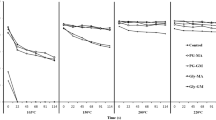Abstract
The aim of this study was to evaluate treatability, morphology and mechanical resistance of composites prepared by in situ polymerization of methyl methacrylate on Pinus taeda wood using glycidyl methacrylate and methacrylic acid as cross-linkers. Treatment consisted of impregnation by vacuum/pressure and polymerization at 90 °C for 10 h using heat catalyst. The treatability was characterized by loads of monomers, conversion of monomers to polymers, weight percent gain, permanent swelling, and densification. The morphology was characterized by SEM images, X-ray diffraction, confocal Raman microscopy, and mechanical properties by static bending, shore D hardness and brittleness tests. Composites with cross-linkers showed the highest monomers retention, and the highest conversion. Brittleness of the composites increased significantly, modulus of elasticity increased from 17 to 32 %, flexural strength increased by 22.4–45.3 %, and shore D hardness increased between 60.2 and 89.6 %. The GMA cross-linker provided the highest increments for mechanical resistance.






Similar content being viewed by others
References
Ang AF, Zaidon A, Bakar ES, Hamami SM, Anwar UMK (2009) Enhancing the properties of Mahang (Macaranga spp.) wood through acrylic treatment in combination with crosslinker. Modern Appl Sci 3:2–10
ASTM D143–94 (2009) Standard test methods for small clear specimens of timber. ASTM International, West Conshohocken
ASTM D2240–05 (2010) Standard test method for rubber property—durometer hardness. ASTM International, West Conshohocken
Devi RR, Maji TK (2006) Effect of chemical modification with styrene and glycidyl methacrylate on the properties of pinewood. Indian J Eng Mater Sci 13:149–154
Devi RR, Maji TK (2012) Chemical modification of simul wood with styrene–acrylonitrile copolymer and organically modified nanoclay. Wood Sci Technol 46:299–315
Devi R, Maji T (2013a) Effect of nanofillers on flame retardancy, chemical resistance, antibacterial properties and biodegradation of wood/styrene acrylonitrile co-polymer composites. Wood Sci Technol 47:1135–1152
Devi RR, Maji TK (2013b) In situ polymerized wood polymer composite: effect of additives and nanoclay on the thermal, mechanical properties. Mater Res 16:954–963
Ding W-D, Koubaa A, Chaala A (2013) Mechanical properties of MMA-hardened hybrid poplar wood. Ind Crops Prod 46:304–310
Gierlinger N, Schwanninger M (2006) Chemical imaging of poplar wood cell walls by confocal raman microscopy. Plant Physiol 140:1246–1254
Hazarika A, Maji TK (2013) Effect of different crosslinkers on properties of melamine formaldehyde-furfuryl alcohol copolymer/montmorillonite impregnated softwood (Ficus hispida). Polym Eng Sci 53:1394–1404
Islam MS, Hamdan S, Jusoh I, Rahman MR, Talib ZA (2011) Dimensional stability and dynamic young’s modulus of tropical light hardwood chemically treated with methyl methacrylate in combination with hexamethylene diisocyanate cross-linker. Ind Eng Chem Res 50:3900–3906
Islam MS, Hamdan S, Hasan M, Ahmed AS, Rahman MR (2012) Effect of coupling reactions on the mechanical and biological properties of tropical wood polymer composites (WPC). Int Biodeterior Biodegradation 72:108–113
Islam MS, Hamdan S, Hassan A, Talib ZA, Sobuz H (2014) The chemical modification of tropical wood polymer composites. J Compos Mater 48(7):783–789
Koubaa A, Ding W-D, Chaala A, Bouafif H (2012) Surface properties of methyl methacrylate hardened hybrid poplar wood. J Appl Polym Sci 123:1428–1436
Kowalski SJ, Kyzioł L, Rybicki A (2002) Composite of wood and polymerized methacrylate. Compos B Eng 33:77–86
Li Y, Wu Q, Li J, Liu Y, Wang X-M, Liu Z (2012) Improvement of dimensional stability of wood via combination treatment: swelling with maleic anhydride and grafting with glycidyl methacrylate and methyl methacrylate. Holzforschung 66(1):59–66
Li Y, XiaoYing D, ZeGuang L, WanDa J, YiXing L (2013) Effect of polymer in situ synthesized from methyl methacrylate and styrene on the morphology, thermal behavior, and durability of wood. J Appl Polym Sci 128:13–20
Mamiński M, Król M, McDonald A, McIlroy D, Niraula I, Czechowska J, Parzuchowski P (2013) Thermally initiated solvent-free radical modification of beech (Fagus sylvatica) wood. Wood Sci Technol 47:1019–1031
Mattos B, Serrano L, Gatto D, Magalhães WLE, Labidi J (2014) Thermochemical and hygroscopicity properties of pinewood treated by in situ copolymerisation with methacrylate monomers. Thermochim Acta 596:70–78
Phuong L, Shida S, Saito Y (2007) Effects of heat treatment on brittleness of Styrax tonkinensis wood. J Wood Sci 53:181–186
Rowell R (1983) The chemistry of solid wood. In: Advances in chemistry series. American Chemical Society, Washington
Segal L, Creely JJ, Martin AE, Conrad CM (1959) An Empirical Method for Estimating the Degree of Crystallinity of Native Cellulose Using the X-Ray Diffractometer. Text Res J 29:786–794
Siau JF (1984) Transport processes in wood. Springer, Berlin
Szilasi SZ, Huszank R, Szikra D, Váczi T, Rajta I, Nagy I (2011) Chemical changes in PMMA as a function of depth due to proton beam irradiation. Mater Chem Phys 130:702–707
Wang X, Du Y, Zhang H, Xu Y, Pan Y, Wu T, Hu H (2014) Fast enrichment and ultrasensitive in situ detection of pesticide residues on oranges with surface-enhanced Raman spectroscopy based on Au nanoparticles decorated glycidyl methacrylate–ethylene dimethacrylate material. Food Control 46:108–114
Acknowledgments
The authors wish to thank CNPq (National Counsel of Technological and Scientific Development), CAPES (Coordination for the Improvement of Higher Education Personnel) and Fundação Araucária for the fellowships, and we thank Ms. Bia Carneiro for the professional support with the English language.
Author information
Authors and Affiliations
Corresponding author
Rights and permissions
About this article
Cite this article
Mattos, B.D., de Cademartori, P.H.G., Missio, A.L. et al. Wood-polymer composites prepared by free radical in situ polymerization of methacrylate monomers into fast-growing pinewood. Wood Sci Technol 49, 1281–1294 (2015). https://doi.org/10.1007/s00226-015-0761-5
Received:
Published:
Issue Date:
DOI: https://doi.org/10.1007/s00226-015-0761-5




